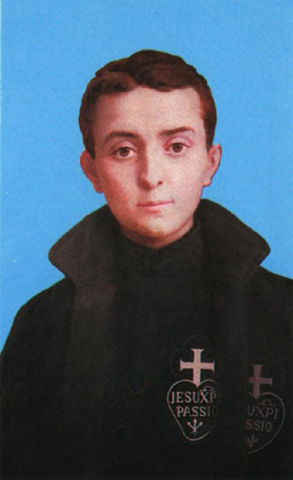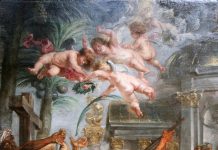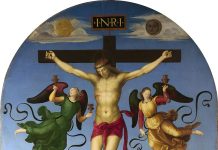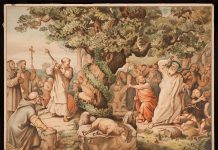Gabriel of the Seven Sorrows, who died on this day in 1862, may be seen as a kind of male Saint Thérèse, but, as in all things male and female, different; Both were difficult, wilfull children, but managed, by the grace of God, to bend those wills to God’s will. Like the French Carmelite, he joined a religious order at a young age – here the Passionists. Both died also at a young age – of complications arising from tuberculosis. Both kept the rule of their Order with great devotion, and offered up their sufferings, maintaining a pleasant, even joyful, disposition, right up to the end. Both were canonized in the 1920’s, when many of the moral evils we are now witnessing had their roots, and to which the lives of these saints give remedy.
Francesco Possenti – such was his birth name – had a tad more circuitous route than the Little Flower. A good-looking lad, he developed into a ladies’ man; not in any gravely sinful sense, but he enjoyed the admiration and flattery of the fairer sex, and would primp and preen himself before going out. He loved to trip the light fantastic, and in the region was known as ‘the Dancer’. Francesco had a girlfriend, or perhaps a particular girl who was a friend, Maria Panachetti, who had hoped he would marry her. Instead, years later, in her old age, she ended up being present at his beatification.
For in this midst of the world’s frivolity, there were the stirrings of a religious vocation in the young man – Francesco was also pious and generous, and maintained his religious duties. Was he, like the rich young man, called higher?
There were signs, and God intervened. Francesco fell gravely ill, and he promised to enter religious life if he lived. He did live, but quickly forgot his promise. So ill he fell again, and, after surviving this second brush with death, during a procession honouring Our Lady, Francecso heard an unmistakable voice asking what he was still doing in the ‘world’.
This time he was resolute, and against all the contrary counsel and advice of his relatives, committed himself to the novitiate of the Passionists in their monastery at the foot of Gran Sasso mountain (a truly lovely spot), taking the name Gabriel of Our Lady of Sorrows. His fellow brothers did not recall anything remarkable in his short life, except, as mentioned, that he strove to keep the rule perfectly, and was always cheerful. His brethren enjoyed spending time at his bedside during his protracted illness, and just before he died in the early morning hours of February 27th, 1862, Gabriel sat up in bed, and opened his arms as though he were being welcomed by someone, with a look of indescribable joy. It was the general opinion that the Virgin Mary herself had brought his soul straight to heaven. He was just 23 years old (hence, just shy of the ‘24’ club of young saints – including Saint Thérèse! – but we may include him as an honorary member, for he was in his 24th year).
Gabriel was beatified on May 31st, 1908 – the feast of the Visitation – by fellow future saint, Pope Pius X, and canonized on May 13th, 1920 by Pope Benedict XV, three years to the day after the first vision at Fatima. His shrine at Gran Sasso is one of the most visited in the world, with millions of pilgrims per year making their way to his tomb. Italian schoolchildren have a custom of going there a hundred days before their final exams to pray for success (Gabriel was an excellent student, after all). There are innumerable miracles attributed to his intercession. Saint Gemma Galgani – also a 24 club member – claimed that he had healed her, which led to her own vocation to the Passionists. May the wonders of these young saints continue unto the Parousia. What joy it is to give one’s youth to God!
A final note: Saint Gabriel Possenti, besides being one of the patron saints of youth, students, seminarians and clerics, is also the patron saint of gun owners, due to a legend that he once scared off with a handgun a band of Garibaldi Red Shirts, that, Italian revolutionaries who were threatening the monastery and village. He demonstrated his proficiency to them by picking off a lizard with deadly accuracy, and they scattered before he might had to demonstrate that same accuracy on them.
Saint Gabriel Possenti, ora pro nobis! +
(source: Wikipedia.org)










